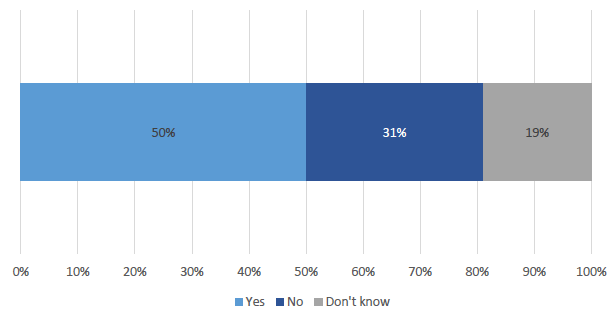Strategic police priorities: consultation analysis
External analysis report of the responses received to the consultation on the revised strategic police priorities.
5. Lifespan and Measurement
This section covers the closed/quantitative analysis of consultation questions 4 and 5. It also includes some qualitative feedback on lifespan and measurement.
5.1 SPP Lifespan
Question 4. Do you agree that the revised Strategic Police Priorities should be in place for a period of six years?
Figure 4: Respondents’ views that the SPPs should be in place for 6 years

Base: 54
Half of the respondents (50%) agreed that the SPPs should be in place for a 6-year period. Just over a third (31%) partially agreed and nearly a fifth (19%) did not agree at all. Organisations were generally more positive about 6-year cycle, 73% said yes compared to 29% individuals.
Note: small base sizes
| Response | Number of Responses |
|---|---|
| Yes | 27 |
| No | 17 |
| Don’t know | 10 |
5.1.1 Timeframe for revision
On the whole, the majority of respondents were positive about the 6-year timeframe.
In general, individuals gave mixed views on the timeframe with some agreeing with 6 years, while others said it should be shorter, and others, longer. In general individuals spoke about the timeframe in terms of planning and measuring trends and outputs of the SPPs.
Some individuals and organisations thought somewhere between 3-6 years would be better and a few commented that the SPPs should be under constant review.
A few organisations felt that 6 years was a long period given the fast pace of change of the political landscape, sustainability issues, and change in crimes and responses. To mitigate this they, along with other individuals and organisations, suggested an interim review during the 6 years. This would allow the opportunity to put measures in place but also provide the ability to react to significant changes.
A few respondents felt that although the SPPs should be in place for the six-year timeframe, they should be monitored and adapted throughout where necessary, and the public, organisations and third sector organisations should be involved in order to input. Respondents liked being able to give feedback.
“It could potentially be for a longer period (10 years); the underlying operational plans will pick up trends etc which are short to medium term. A longer term allows a more comprehensive analysis/ data opportunity to really evaluate the impact of the priorities.”
Individual
This being said, the majority of organisations actually agreed about the timeframe. They felt it was a decent length of time in performance measurement terms. They also thought it would allow for analysis and to see if strategies implemented were having the desired impact and for time to effect change. This is potentially due to their more strategic outlook of the SPPs compared to individuals.
“Yes – we would agree with the view that it is appropriate to set longer term strategic direction.”
Organisation
Some concern was also expressed over the time/flexibility to allow local police plans to fully consider implications of other strategy documents before taking the SPPs forward.
5.2 Progress Measurement
Question 5. How do you think the progress towards delivering the Strategic Police Priorities should be measured?
There were two key themes arising for how to measure the progress of the SPPs.
5.2.1 Consultation
The first was measurement via consultation and surveys in order to gain opinions and feedback. Individuals and organisations felt that by engaging with and listening to the public and the community and asking what they think would be key. Working together was highlighted as being very important including working with partners.
“In terms of evidencing performance, we would suggest that this should include consultation and engagement with communities, stakeholders (e.g. partners)..”
Organisation
5.5.2 Data
The other key theme was around data. Individuals and organisations felt that KPIs should be set under a performance framework and different datasets should be collated in order to measure the impact e.g. crime statistics, community wellbeing. Qualitative and quantitative measures were suggested along with reporting.
“Police Scotland are data rich and should continue to review and analyse trends to assess if priorities are leading to successful outcomes.”
Local Authority
Contact
Email: michelle.wallace@gov.scot
There is a problem
Thanks for your feedback